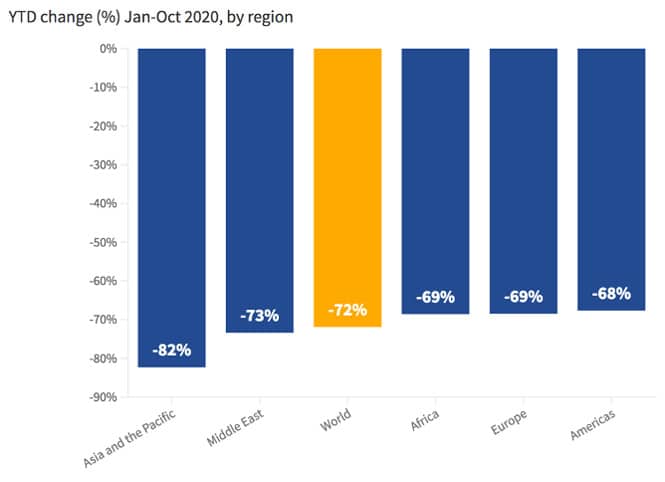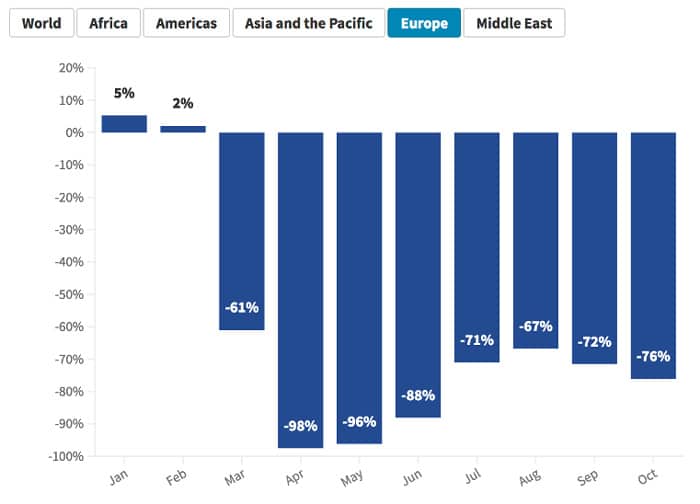New UNTWO data measures pandemic’s toll on global tourism
- 2020 is “the worst on record in the history of tourism” according to the UNTWO
- International traveller arrivals are expected to down by 1 billion compared with 2019 when data for the whole of the year is tallied
- UNWTO Secretary-General Zurab Pololikashvili says that there is urgent need for innovations and processes that can allow countries to more safely open borders
- The global tourism sector is expected to begin rebounding in the second half of 2021
The latest UNTWO data confirms that 2020 is “the worst year on record in the history of tourism.” The loss of US$935 billion in export revenues between January and October of this year is more than 10 times the loss the industry experienced in 2008/09 during the global economic recession.
In November, experts predicted that arrivals would be down close to 70% for the year, and the new data shows that they have fallen 72% through October, with 900 million fewer international travellers arriving at global destinations between January and October of 2020 than in the same period last year.
If arrivals drop by 70–75% for the whole of 2020, as is expected, “global tourism will have returned to levels of 30 years ago, with 1 billion fewer arrivals and a loss of some US$1.1 trillion in international tourism receipts. This massive drop in tourism due to the pandemic could result in an economic loss of US$2 trillion in world GDP.”
In a press release covering the new data, UNWTO Secretary-General Zurab Pololikashvili said that the tourism industry has been among the worst hit of all sectors by the pandemic and emphasised the urgency of opening borders:
“Since the start of this crisis, UNWTO has provided governments and businesses with trusted data showing the unprecedented impact of the COVID-19 pandemic on global tourism. Even as the news of a vaccine boosts traveller confidence, there is still a long road to recovery. We thus need to step up our efforts to safely open borders while supporting tourism jobs and businesses. It is ever clearer that tourism is one of the most affected sectors by this unprecedented crisis.”
The most affected region so far is Asia-Pacific. China was the epicentre of the pandemic at the beginning of 2020, and along with countries such as New Zealand and Australia, it has been strict about keeping borders closed to beat back infection rates. This choice of policy is helping to slow the spread of COVID but it is not surprising to see this region encounter the steepest declines in arrivals as a result.

The UNTWO presentation of the January–October 2020 data includes an interactive chart showing tourism levels for each of the regions in different months of the year. The only region that shows much variability is Europe (shown below), where we can see a slight reprieve from the steep losses in arrivals beginning in the summer, when many EU countries eased travel restrictions. In other regions where governments did not significantly alter their border policies through the year, there was a more constant trendline of severe losses.

Recovery expected in second half of 2021
Few destinations are showing signs of recovery in their tourism sectors yet; only Germany, France, and the US have seen a little more activity even though the UNTWO notes that “the proportion of closed destinations has dropped from 82% in late April 2020 to 18% in early November.”
The UNTWO believes that vaccines as well as improved ways of safely opening borders may slowly restore consumer confidence in 2021 and forecasts a rebounding of global tourism in the second half of next year. A return to 2019 levels is not expected for two-and-a-half to four years.
The path towards more open borders
An related, and ongoing, UNTWO study, the Travel Restrictions Report has found that countries that have opened their borders the fastest are those “with higher scores in health and hygiene indicators” and that these destinations are “increasingly applying differentiated, risk-based approaches to implementing travel restrictions.”
UNWTO Secretary-General Zurab Pololikashvili says that,
“A coordinated approach to easing and lifting restrictions on travel whenever is it safe to do so is essential. This will not only open destinations up to tourism again, but clear and consistent rules between countries will go a long way towards building back trust in international travel and boosting consumer confidence.”
There are several initiatives underway to create digital health passports for travellers that will be accepted on a worldwide basis. These passports store travellers’ verified test results and allow the results to be shown to airline and border officials. The goal of them is to smooth immigration processes, to boost safety and traveller confidence, and to reduce or even replace reliance on quarantine – all results that would encourage more tourism. Some passports are already being trialled for certain international flight routes, and more widespread use of them is expected next year.
For additional background, please see:
















